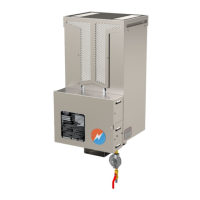Global Power Technologies PRODUCT INFORMATION
302842 Rev0 | Sentinel Page 10 of 61
2.5 ELECTRONICS USER INTERFACE
The Sentinel Thermoelectric Generator includes:
A preheater which heats up the catalytic pad to the required activation temperature during the
start-up period.
A start-up battery pack that powers the preheater. It also contains a fuse which provides
reverse-polarity battery protection.
Thermoelectric modules that convert heat energy generated from combusting natural gas fuel to
electrical energy.
A circuit board which contains a start-up battery charger, a control circuit to control the
preheater, and a DC/DC converter to convert the electrical energy generated by Thermoelectric
Modules to 12V/24V DC to power customer loads.
All the electronic components are contained within the electronics enclosure located inside the
instrumentation enclosure. User Interface on the main electronics board include:
Buttons and switches:
Red PREHEAT CYCLE (Preheat Cycle) button (SW500) — engages the preheating element during
start-up.
T.COMP.ON / T.COMP.OFF switch (SW300) —enables and disables the customer output voltage
temperature compensation feature of the DC/DC Converter. Also referred to as Temperature
Compensation Switch in this manual. For details about this feature refer to Section 4.3.5.
OCV/RUN toggle switch (SW200) — toggles between RUN and OCV mode;
o OCV — used during set-up. Toggle to this mode to measure the open circuit voltage.
o RUN — used when the TEG is operating. Toggle to this mode when set-up is completed and
the Sentinel TEG is ready to operate.
Sockets MP200 & MP201:
[ + VPU – ] — to connect a voltmeter to when measuring power unit voltage. The Sentinel TEG
open circuit voltage is measured across VPU+ and VPU– while the SW200 toggle switch is set to
the OCV position.
Potentiometer:
VOLTAGE ADJUST potentiometer (RV300) — used to adjust customer output voltage.
Terminal Connections:
[ + TEG OUT – ] — to connect the customer load
[ + LV ALARM – ] — to signal customer the condition of output voltage. These are outputs of a
solid-state relay. Low impedance indicates the customer output voltage is in normal range; in this
case the LV Alarm LED indicator is off. High impedance indicates the customer output voltage is
lower than nominal range, in this case the LV Alarm LED indicator turns on yellow.
[ + BATTERY – ] — to connect the start-up battery pack.
Connectors:
PREHEATER — to connect the preheating element in the Catalytic Heater Cartridge
MODULE 1 and MODULE 2 — to connect Thermoelectric Modules in the power unit assembly

